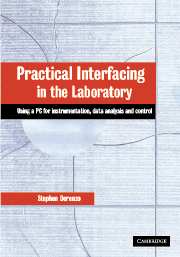Book contents
- Frontmatter
- Contents
- Preface
- Acknowledgments
- 1 Digital tools
- 2 Analog tools
- 3 Analog ↔ digital conversion and sampling
- 4 Sensors and actuators
- 5 Data analysis and control
- Appendix A Grounding and shielding
- Appendix B Experimental uncertainties
- Appendix C C programming tips
- Appendix D Numerical methods and C functions
- Appendix E Summary of Data Translation DT3010 PCI plug-in card
- Appendix F Using the digital oscilloscope to record waveforms
- Appendix G Electrical hazards and safety
- Appendix H Standard resistor and capacitor values
- Appendix I ASCII character set codes
- Glossary
- Index
Appendix D - Numerical methods and C functions
Published online by Cambridge University Press: 04 August 2010
- Frontmatter
- Contents
- Preface
- Acknowledgments
- 1 Digital tools
- 2 Analog tools
- 3 Analog ↔ digital conversion and sampling
- 4 Sensors and actuators
- 5 Data analysis and control
- Appendix A Grounding and shielding
- Appendix B Experimental uncertainties
- Appendix C C programming tips
- Appendix D Numerical methods and C functions
- Appendix E Summary of Data Translation DT3010 PCI plug-in card
- Appendix F Using the digital oscilloscope to record waveforms
- Appendix G Electrical hazards and safety
- Appendix H Standard resistor and capacitor values
- Appendix I ASCII character set codes
- Glossary
- Index
Summary
Introduction
This appendix describes some numerical methods useful in microcomputer-based data analysis. The fast Fourier transform function performs a discrete Fourier transform of a waveform sampled at periodic time intervals. The PARFIT function permits nonlinear fitting by varying parameters to minimize a goodness-of-fit quantity (such as chi-squared). The VARFIT function varies the parameters about their best-fit values to determine their statistical uncertainties. The ADSINT function performs numerical integration using adaptive quadrature and dynamically divides the integration interval into smaller steps to evaluate the integral with the desired accuracy and the minimum number of integrand evaluations. An example is given for computing the probability of exceeding a particular value of Student's t. Several methods for function inversion are given using both Newton's method and quadratic approximation. The ADSINT function and Newton's method were used to compute the chi-squared and Student's t probability tables in Chapter 5. The RAMDOME function provides floating point numbers randomly distributed between 0 and 1 with 231 different values, a period of 261 numbers, and with a low degree of correlation.
Fast Fourier transform
The fast Fourier transform (FFT) is discussed in Section 5.8. This algorithm is basically a way to compute the discrete Fourier transform rapidly.
- Type
- Chapter
- Information
- Practical Interfacing in the LaboratoryUsing a PC for Instrumentation, Data Analysis and Control, pp. 517 - 552Publisher: Cambridge University PressPrint publication year: 2003



